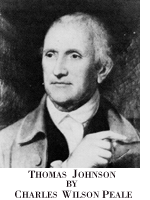

 This painting could be fairly important not only because the artist is nationally recognized but because of the ancestry of the sitter. This painting could be fairly important not only because the artist is nationally recognized but because of the ancestry of the sitter.
According to Paul Heinegg, author of "Free People of Color in North Carolina," this Thomas
Johnson, a wealthy Maryland planter, was none other than the great grandson of Anthony Johnson, one of the earliest African Americans to settle Virginia. And it is this very Anthony Johnson who is a pivotal figure in the debate over the origins of slavery.
Anthony Johnson had acquired close to a thousand acres of land by the middle of the 17th century and was among the first generation of free blacks whose relative affluence have forced scholars of the Colonial south to revise their original views on the origins of American slavery and the fine line between this "peculiar" institution and indentured servitude.
What makes Anthony Johnson a central figure in the debate is an utterly bizarre and "politically incorrect" twist of fate. From evidence found in the earliest legal documents extant, it is Anthony Johnson who we now must recognize as the nation's first slaveholder. After all, the court battle he eventually won in 1655 to keep John Casor (Ceasar?) as his servant for life, identifies this unfortunate soul as the first slave in the recorded history of our country. Claiming that he had been imported as an indentured servant, Casor attempted to transfer what he argued was his remaining time of service to Robert Parker, a white, but Johnson insisted that "hee had ye Negro for his life".
The court ruled that "seriously consideringe and maturely weighing the premisses, doe fynde that the saide Mr. Robert Parker most unjustly keepeth the said Negro from Anthony Johnson his master....It is therefore the Judgement of the Court and ordered That the said John Casor Negro forthwith returne unto the service of the said master Anthony Johnson, And
that mr. Robert Parker make payment of all charges in the suit."
Even though it is quite possible for a bi-racial person to favor only one of the parents, the reason for the totally European features of the portrait is obviously the proportion of his white to black ancestry. According to some historians, since both Anthony Johnson and his wife were possibly Hispanic, there might have already been some Caucasian admixture
in either one or both of their genetic makeups. Indeed a son was officially described as "Richard Johnson Mollatto." Although Susanna, the wife of John, another son of theirs, is
noted as black, it has also been documented that this John had also produced offspring with Hannah Leach, a white.
Heinegg suggests that the father of the sitter in the above Peale portrait, is John's son, Anthony, obviously named for his grandfather. However, because of how old he would have been at the time of his marriage, (between 45 and 50 in 1699), my personal suspicion is that he was, instead, John's grandson. Whatever the case, this particular Anthony's wife was white and if Heinegg has indeed skipped a generation, then his mother was also white since we do know that Elizabeth the wife of John's son, John Jr., was also white.
Besides the recurrence of the name Anthony, it should be pointed out here, as well, that this was the branch of the family that had migrated to Maryland by the end of 1665. Because there are no other Anthony Johnsons in the state records that would make sense, the following is my own take on the genealogical tree of the subject in the above portrait.
Anthony Johnson m. Mary (hispanic blacks)

John Johnson m. Susan (black)
 Hannah Leach (white) Hannah Leach (white)

John Johnson Jr. m. Elizabeth (white)

Anthony m. 1699 Catherine Smith (white)

Thomas Johnson
Needless to say, since Thomas Johnson
wife was also white, his sons and daughters married into the local
planter class of which they had already become important members.
Researched and Written by Mario de Valdes y Cocom.
|